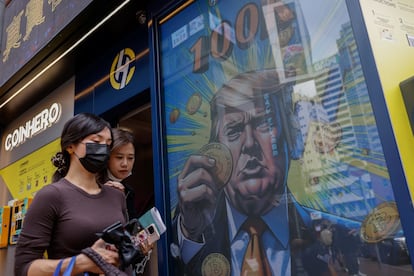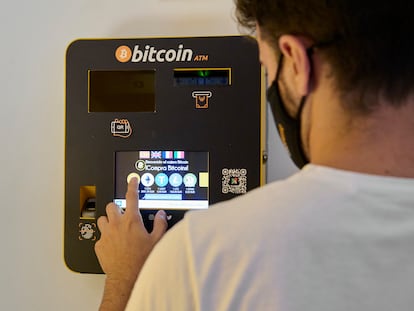Bitcoin’s tortuous path to the top: From zero to $100,000 in 16 years
The leading cryptocurrency is enjoying its best moment, having overcome price crashes, platform bankruptcies, and relentless criticism

There was a time when one bitcoin wasn’t enough to buy a pizza — not even 1,000 bitcoins. The first transaction involving this cryptocurrency took place in 2010, when two pizzas from the U.S. chain Papa John’s were purchased for $41, paid with 10,000 bitcoins. Had Laszlo Hanyecz, a programmer from Jacksonville, kept those bitcoins instead of offering them on an internet forum to anyone who would deliver the pizzas, today he would have more than $1 billion. Every May 22, the crypto community marks the anniversary of this historic transaction, more with nastiness than nostalgia, as they reflect on the growing cost of the most expensive meal in history.
In Hanyecz’s defense, few could have predicted that this unknown, nascent digital currency — created by the anonymous Satoshi Nakamoto — would one day be a global investment phenomenon, sought after by millions. While bitcoin has since surpassed the long-awaited $100,000 per coin, the cryptocurrency’s rise was gradual and fraught with challenges, some of which may still lie ahead.
In a 2013 article for EL PAÍS, Javier Martín del Barrio wrote: “If you want a bitcoin, ask for Escalicha in Cambrils, who sells them at €845 [$893], or better yet, Basybil from Seville, who deals at €503 [$532]. Meet online in a café, and bring your smartphone to check the transfer of this virtual currency, which is neither seen nor touched and doesn’t really exist, but in January was worth €10 [$10.60], and by now costs €500 [$528], fluctuating according to the whim of a mysterious, anonymous market that is growing more widespread every day.”
Pablo Romero, a consultant for the Carbono.com platform, recalls those beginnings as a time of uncertainty. “Owning bitcoin in the early days was complicated. You had to install the Bitcoin Core software, and to make a transaction, you had to synchronize your computer with the rest of the network, which could take days.”
Looking back, those were times of precariousness and word-of-mouth exchanges. There was no Binance — the world’s largest cryptocurrency exchange — nor was Coinbase, another major player, more than a fledgling idea. The risks were palpable. In 2014, Japanese exchange Mt. Gox filed for bankruptcy after hackers stole around €284 million ($300 million) worth of bitcoins from customer accounts. Two years later, hackers stole €58 million ($61 million) in bitcoins from the Hong Kong-based Bitfinex exchange.
Despite these setbacks, bitcoin’s value quickly rebounded. In January 2017, it surpassed $1,000 for the first time, and by November of the same year, it had soared to $10,000, nearing $20,000 in December. However, 2018 brought a reality check and the first of many prophesied “deaths” for bitcoin. The price plummeted by 80%, dropping to less than $4,000 — its worst year yet. It was a string of bad news: U.S. authorities launched an investigation into possible market manipulation, G-20 leaders accused cryptocurrencies of enabling money laundering, and global institutions like the IMF and the BIS issued stark warnings about their risks.
Bitcoin’s resurgence didn’t come until November 2020, after the worst of the Covid-19 pandemic had passed. It finally reached the $20,000 mark that had eluded it three years earlier. The pandemic, with millions of government stimulus checks and endless hours spent at home, sparked a wave of new investors who discovered bitcoin and dreamed of getting rich quick. Among them was even one of Christine Lagarde’s sons, who, despite his mother’s warnings as a former president of the European Central Bank (ECB), ventured into cryptocurrencies (she did not specify which coins) — ultimately with disastrous results, as she later admitted.
The post-pandemic boom
Bitcoin’s meteoric rise was fueled by the massive savings accumulated during the pandemic, when spending on restaurants and leisure was nearly impossible. Ultra-low interest rates, which made deposits and public debt yield little to no returns, also encouraged many to take on riskier investments. Bitcoin surged, surpassing $30,000 and $40,000 in January 2021, and hitting $50,000 and $60,000 by February, marking the start of a year of extraordinary growth. Then, an unexpected blow came: the TerraLuna cryptocurrency collapsed in a matter of hours, wiping out millions of investors’ savings worldwide.
This cataclysm raised a critical question: Could something like this happen to bitcoin? The answer came in the form of sharp drops, up to 50%, throughout the summer, followed by a powerful rebound to a new record high of $69,000 in November. Once again, the crypto community began eyeing the $100,000 mark as the next big milestone.
However, the landscape shifted as inflation made a strong return, central banks raised interest rates, and bitcoin descended into a “cryptowinter” — a dark period whose lowest point came with the November 2022 bankruptcy of the FTX platform. Jorge Soriano of the Criptan platform recalls: “It was one of the worst moments in bitcoin’s history — not only because of the size of the financial loss, but because it completely eroded trust in industry players. We all became potential FTX victims. In a matter of minutes, it wiped out years of effort in which we tried to prove that cryptocurrencies were not for money laundering or other crimes.”
FTX’s founder, Sam Bankman-Fried, once seen as a wunderkind, who had become a billionaire before the age of 30, was arrested and sent to prison. Again, uncomfortable questions arose: Would Binance be the next to fall? Was bitcoin strong enough to survive such a blow? The price plunged to $16,000, leaving millions of small investors trapped. Critics proclaimed that the bubble had finally burst. But bitcoin had more resilience than many expected. The cryptowinter passed, confidence was slowly restored with the approval of ETFs in the U.S., which eased the entry of both retail and institutional investors, and then, following Donald Trump’s electoral victory, and his campaign full of promises favorable to the crypto space, in the early hours of Thursday, bitcoin reached the milestone of $100,000.

Bubble or store of value?
This achievement, however, has not settled the ongoing debate surrounding bitcoin. Sixteen years after its creation, its path continues to be marked by stark contrasts between its market performance and the opinions of experts. “Bubble!” echo the critics, from central bankers to Nobel-winning economists, who compare bitcoin to the Dutch tulip mania of the 17th century. They ask: without revenue, profits, new products, services, or dividends like traditional companies, what sustains its value?
Bitcoin’s defenders, however, offer a different perspective, pointing out that gold, too, lacks those characteristics, yet serves as a store of value. They place bitcoin in the same category of assets designed to preserve wealth.
Álvaro D. María, author of La Filosofía Bitcoin (The Bitcoin Philosophy), is one of its defenders. “Bitcoin is unique. Its properties are not derived from blockchain, but from its incentive system [miners, code and nodes] and the scale it has reached. Other cryptocurrencies do not compete with bitcoin, but are centralized projects to be valued as if they were startups. Bitcoin plays in the league of assets like long-term public debt, real estate, gold, and shares of established companies, and pension and investment funds,” he argues.
Roland Gillet, a professor of financial economics at the Sorbonne and Université Libre de Bruxelles, takes a different view. He believes the bitcoin boom rests on something far more fragile: trust. “When people stop believing in a bank, there’s a bank run,” he explains. “With bitcoin, a lot of people are making money without really knowing why. If, at any given moment, collective intelligence realizes that it’s all just speculation and that there’s nothing behind it, many will lose money,” he warns.
Sign up for our weekly newsletter to get more English-language news coverage from EL PAÍS USA Edition
Tu suscripción se está usando en otro dispositivo
¿Quieres añadir otro usuario a tu suscripción?
Si continúas leyendo en este dispositivo, no se podrá leer en el otro.
FlechaTu suscripción se está usando en otro dispositivo y solo puedes acceder a EL PAÍS desde un dispositivo a la vez.
Si quieres compartir tu cuenta, cambia tu suscripción a la modalidad Premium, así podrás añadir otro usuario. Cada uno accederá con su propia cuenta de email, lo que os permitirá personalizar vuestra experiencia en EL PAÍS.
¿Tienes una suscripción de empresa? Accede aquí para contratar más cuentas.
En el caso de no saber quién está usando tu cuenta, te recomendamos cambiar tu contraseña aquí.
Si decides continuar compartiendo tu cuenta, este mensaje se mostrará en tu dispositivo y en el de la otra persona que está usando tu cuenta de forma indefinida, afectando a tu experiencia de lectura. Puedes consultar aquí los términos y condiciones de la suscripción digital.
More information
Archived In
Últimas noticias
Chris Martin, Taylor Swift, Elijah Wood and other famous wedding ‘crashers’
‘How does it feel to be a failure?’: Elizabeth Berkley’s journey from ‘Showgirls’ ridicule to vindication
The story of the Málaga virus: The code that haunted Google’s cybersecurity center director for 30 years
The impact of Ecuador’s mega-prison: A polluted river, cleared forests and military checkpoints
Most viewed
- Christian Louboutin: ‘Young people don’t want to be like their parents. And if their parents wear sneakers, they’re going to look for something else’
- The low-cost creative revolution: How technology is making art accessible to everyone
- Liset Menéndez de la Prida, neuroscientist: ‘It’s not normal to constantly seek pleasure; it’s important to be bored, to be calm’
- All the effects of gentrification in one corner of Mexico’s Colonia Roma
- December Social Security and SSI payments: Dates, double checks and the 2026 COLA increase










































